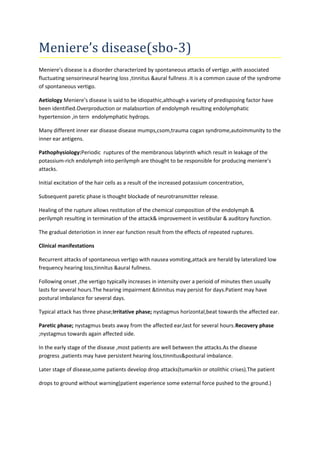
Meniere's disease(sbo 3)
- 1. Meniere’s disease(sbo-3) Meniere’s disease is a disorder characterized by spontaneous attacks of vertigo ,with associated fluctuating sensorineural hearing loss ,tinnitus &aural fullness .It is a common cause of the syndrome of spontaneous vertigo. Aetiology Meniere’s disease is said to be idiopathic,although a variety of predisposing factor have been identified.Overproduction or malabsortion of endolymph resulting endolymphatic hypertension ,in tern endolymphatic hydrops. Many different inner ear disease disease mumps,csom,trauma cogan syndrome,autoimmunity to the inner ear antigens. Pathophysiology:Periodic ruptures of the membranous labyrinth which result in leakage of the potassium-rich endolymph into perilymph are thought to be responsible for producing meniere’s attacks. Initial excitation of the hair cells as a result of the increased potassium concentration, Subsequent paretic phase is thought blockade of neurotransmitter release. Healing of the rupture allows restitution of the chemical composition of the endolymph & perilymph resulting in termination of the attack& improvement in vestibular & auditory function. The gradual deteriotion in inner ear function result from the effects of repeated ruptures. Clinical manifestations Recurrent attacks of spontaneous vertigo with nausea vomiting,attack are herald by lateralized low frequency hearing loss,tinnitus &aural fullness. Following onset ,the vertigo typically increases in intensity over a perioid of minutes then usually lasts for several hours.The hearing impairment &tinnitus may persist for days.Patient may have postural imbalance for several days. Typical attack has three phase;Irritative phase; nystagmus horizontal,beat towards the affected ear. Paretic phase; nystagmus beats away from the affected ear,last for several hours.Recovery phase ;nystagmus towards again affected side. In the early stage of the disease ,most patients are well between the attacks.As the disease progress ,patients may have persistent hearing loss,tinnitus&postural imbalance. Later stage of disease,some patients develop drop attacks(tumarkin or otolithic crises).The patient drops to ground without warning(patient experience some external force pushed to the ground.)
- 2. Diagnosis of meneire’s disease: American Academy of Otolaryngology –head & neck surgery has published diagnostic guidelines for Meneire’s disease. Definite Meneire’s disease;two or more spontaneous attack of vertigo(each lasting 20minute or Longer)Hearing loss documented by PTA at least one occasion,tinnitus or aural fullness on the affected side. Probable Meneire’s disease;two or more spontaneous attack of vertigo with unilateral loss,tinnitus, Or aural fullness all at same time. A possible meneire’s disease;two or more spontaneous attack of vertigo,no auditory symptom during attack. In early stages of Meniere’s disease,vestibular &auditory function tests are often completely normal between attacks.A fluctuating low-frequency sensorineural hearing loss may be seen & is suggestive of the diagnosis of the early stage of the disease. As the disease progresses,all frequencies are affected resulting in a flat sensorineural hearing loss that is at least moderate in severity. Electrocochleograpgy; most sensitive & specific for meniere’s disease when tone-burst &click stimuli are used. Recorded transtympanically at the promontory. Giving 4gm of nacl for 3days prior to the electrocochleogram may increase the sensitivity. Management options: aim to decrease the production or accumulation of endolymph.Strict sodium restriction (so that uninary sodium is less than 50mmol/day) &diuretic can be effective in reducing the frequency of vertigo. Surgery; Endolymphatic sac surgery,selective vestibular neurectomy.labyrinthectomy with cochlear implantation. Recently intra tympanic inj. Of gentamycin may be effective to control severe intractable vertigo in most patients. Outcomes &complications; the natural history of meniere’s disease is variable.Attacks may occur days ,months ,even year apart, with little or no warning. In most patients only one ear is affected in early stage of disease, unfortunately the second ear involved in about half of the patients . Treatment of meniere’s disease(p 3798) The treatment of meniere’s disease should be preceded by diagnosis on the basis of strict criteria& after exclusion of retrocochlear pathology.
- 3. 1)General measures:Level of anxiety correlates with the severity of symptoms in the patients with Meniere’s disease,it is postulated that stress may contribute via autonomic mechanisms in the genesis of endolymphatic hydrops. Increase prevalence for both inhalant & food allergies in patients with meniere’s diseae& it has been suggested that allergy immunotherapy & food elimination may be benefit in these cases. 2) Diet: to restrict salt intake to 1mg or 1.5 -2mg /day in order to address endolymphatic hydrops. 3)Drug therapy:Drug therapy for Meniere’s disease may include, a)Acute vestibular symptoms suppression by anticholinergic ,antihistaminic,calcium channel antagonist. b)Drug that aim to influence endolymphatic hydrops which include diuretics & betahistine. c)Suppression of immunological reactions with steroids or methotrexate. d)Deastruction of the vestibular end organ by intratympanic injection of aminoglycosides. Diuretics may be effective in the long term control of vertigo but not of cochlear symptoms. Dyazide has been reported as effective in controlling vertigo. Betahistine is a histaminic analogue with weak agonistic of both H1 & H2 ,moderate antagonistic action of H3 histaminic receptors. a) A reduction of the symmetric functioning of the vestibular end organ. b) Improved microvascular circulation in the stria vascularis of the cochlear. c) Inhibition of the activity in the vestibular nuclei. d) Less alertness effects on alertness through cerebral H1 receptors. Suppression of immunogical reaction:oral recommended treatments include high doses of prednisolone for one month with slow tapering over 4 to 6 months. Intratympanic injection of aminoglycoside.
